After Perry (1794-1858) fleet Japan in 1853, yokohama-e that show lovely Yokohama port and kaika-e that show the westernization such as the opening of Railroad service in 1872 (Meiji 5th), exhibitions and new famous sights got to be popular in 1860s. At that time, the color of red or purple created by synthetic dye of aniline were started to be imported. Ukiyo-e artists competed with one another in trying to use this new material on many types of ukiyo-e in the early Meiji period and the art works attracted attention very much.
In the early Meiji period when an inflow of foreign cultures accelerated, ukiyo-e became the focus of attention because of its aspect as a tool of news for starting of newspapers or magazines, participation on exhibitions in and out of Japan and change of political systems. In 1872 (Meiji 5th), “Tokyo Nichi-nichi Shinbun” (shinbun means newspaper) whose e-shi (paint artist) was Ochiai Yoshiiku and “Yūbin Hōchi Shinbun” whose e-shi was Tsukioka Yoshitoshi were first launched. These newspapers were not for intelligent people but for ordinary people. Their subjects were also for ordinary people and included articles with pronunciation characters and illustrations. They have been called as Shinbun-nishiki-e. They attracted attentions such as tabloid TV programs or weekly magazines of the present-day.
On the other hand, e-shi’s unique expressions were stimulated by the inflow of foreign cultures or the proceeding of minuteness of suri (printing) and hori (carving). Among those expressions, “Kōsen-ga” (Kōsen means a ray of light) by Kobayashi Kiyochika is particularly special. He expressed delicate states of light, sky or space by shades of multiple colors except drawing outlines.
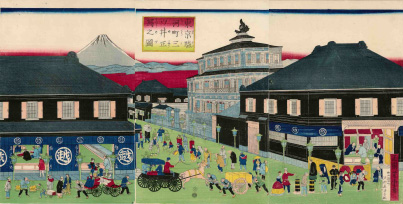
Utagawa Yoshitora
“Tokyo Suruga-machi Mitsui Sei-sha no Zu” Meiji 7th (1874)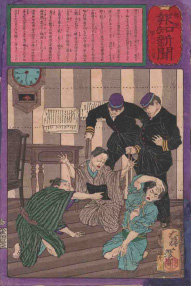
Tsukioka Yoshitoshi
“Yūbin Hōchi Shinbun Dai Yon-hyaku-hachijū-yon go” Meiji 8th (1875)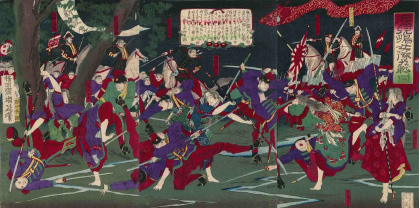
Yōshū Chikanobu
“Kagoshima Onna-tai Rikisen Zu” Meiji 10th (1877)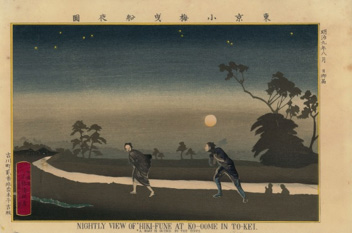
Kobayashi Kiyochika
“Tokyo Ko-ume Hiki-hune Yo Zu” Meiji 9th (1876)
From Meiji 20s onward, the style of ukiyo-e that was stylized and continued from Edo period was declining and traditional woodblock prints had taken a turn for not being the center of prints. Ukiyo-e was at the peak of its skills or demands from the end of Edo period to the beginning of Meiji period and ukiyo-e was the center of the paintings for ordinarily people not only on the subjects of yakusha-e (ukiyo-e of actor) and bijin-ga (ukiyo-e of beautiful woman) but also new subjects till the middle of Meiji 10s.
Essentially, ukiyo-e can be marketable by getting and corresponding to the tastes of the time. The beginning of Meiji was the end of time that the Edo ukiyo-e could hold its tradition and correspond to the demands of ordinarily people who accepted the inflow of new cultures.
We introduce 3 of ukiyo-e-shi who inherited Edo ukiyo-e and played active parts after the decease of top 3 e-shi in the end of Edo period.
- Toyohara Kunichika 1835 to 1900 (Tenpō 6th to Meiji 33rd)Open or Close
Kunichika represents the e-shi in the first half of Meiji period and called “Yakusha-e no Kunichika” (Kunichika of Yakusha-e). He was born in Kyobashi, Edo, studied under Toyohara Chikanobu when he was about 10 and draw portraits of yakusha (actor) on hagoita (battledore) and so on. At the age of 14 he became a disciple of Utagawa Kunisada (the 3rd Toyokuni) who was the top e-shi and was good at yakusha-e and bijin-ga. Putting Toyohara Chikanobu and Utagawa Kunisada together, he gave his name as Toyohara Kunichika (in kanji characters, his name is the combination of the names of both of his masters) and had a good reputation as “Yakusha-e no Kunichika” after yakusha-nigao-ookubi-e (actor’s portrait with his face mainly) in 2nd Meiji. The top 3 ukiyo-e-shi or big stars of kabuki were passed away before new era of Meiji, and yet Kunichika enlivened the worlds of kabuki and ukiyo-e in Meiji era with young kabuki actors.
It is said that he was a man who spent his earnings for the day before the night is out, moved more than 100 times, had about 40 wives in his lifetime, loved sake and had chivalrous spirit to save people in distress. He had created art works with spirits of iki (smart or stylishness) of Edo by adding realistic with the years.
“Goko Haiyū Tsui Tatehiki”
Meiji 5th (1872)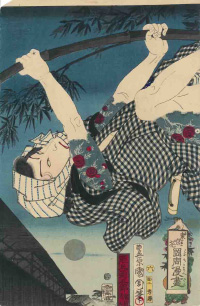
“Tokyo Hana Kunichika Manga Onoe Kikugorō Oniazami Seikichi”
Meiji 5th (1872)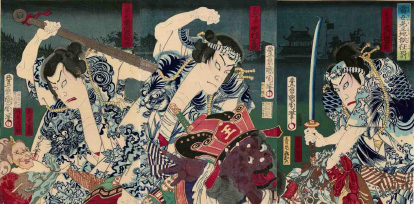
“Tōsē Mitate Jigoku Seibatu”
Meiji 9th (1876)-
“Haru Mitate Tō Hagoita Bandō Hikozaburō Nakamura Shikan”
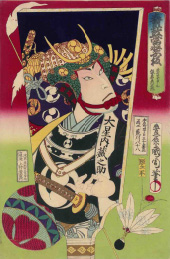
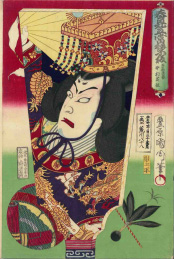
Beginning of Meiji period 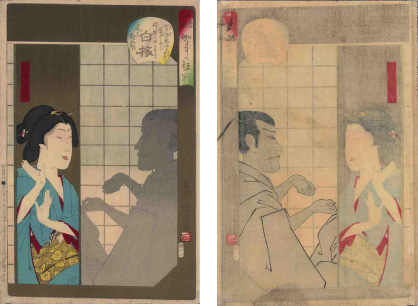
“Haiyū Geiko Kage no Hyōban Shira-ume Onoe Kikugorō”
Meiji 16th (1883)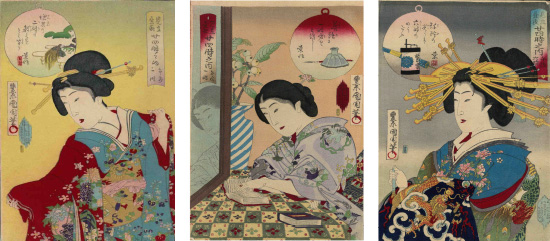
'Mitate Chūya Nijū-yo-ji no uchi (Chiri-men/Crepe Version)'
“2 a.m.” “1 p.m.” “6 p.m.”
Meiji 23rd (1890)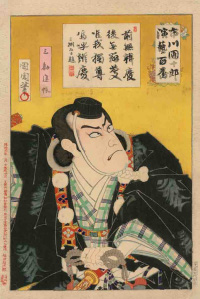
“Ichikawa Danjūrō Engei Hyaku-ban San Kanjinchō”
Meiji 26th (1893)
- Tsukioka Yoshitoshi 1839 to 1892 (Tenpō 10th to Meiji 25th)Open or Close
His real name is Yoshioka Yonejirō and was born in a merchant’s family as their second male child. In 1849, at the age of 10, he became a disciple of Utagawa Kuniyoshi. There were also Kawanabe Kyōsai, Ochiai Yoshiiku, Utagawa Yoshihuji and so on. It is said that they worked very hard to skill up by doing competitions. After the practice era, he created various kinds of ukiyo-e like bijin-ga, yakusha-e, huzokū-ga (ukiyo-e of custom), rekishi-ga (historical ukiyo-e) and so on. He has been known as an e-shi who succeeded even when ukiyo-e had started be declining. From about 1865, he had used the family name “Tsukioka” because he became heir to Tukioka family that Tukioka Sessai was belong to.
Speaking of Yoshitoshi, gruesome ukiyo-e called “chimidoro-e” (bloody ukiyo-e) such as “Eimei Nijū-ha-shū-ku” or “Kaidai Hyaku-sen-sō” that were created in the beginning of Meiji period are very famous art works. It is said that he created these gruesome prints based on the sketches of Shōgi-tai who destroyed in the war of Boshin. The subjects of ukiyo-e should always be the ones that got public attentions and these chimidoro-e was the one of them. Later, novelists such as Akutagawa Ryūnosuke, Tanizaki Junichirō and Mishima Yukio were influenced by these ukiyo-e.
In Meiji 5th, Yoshitoshi got a nervous disease. But after the recovery, he created bijin-ga such as “Tokyo Jiman Jūni-kagetu” or “Hūzoku Sanjū-ni-sō” and rekishi-ga such as “Wakan Hyaku Monogatari”. As the series of “Tsuki Hyaku-shi” (figures of one hundred moon), he created 100 works whose subjects are the moon and various sights of legends in Japan and China. They show the ability in his later years.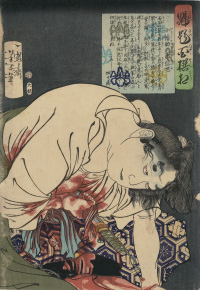
“Kaidai Hyaku-sen-sō Obata Sukerokurō Nobuyo”
Meiji 1st (1868)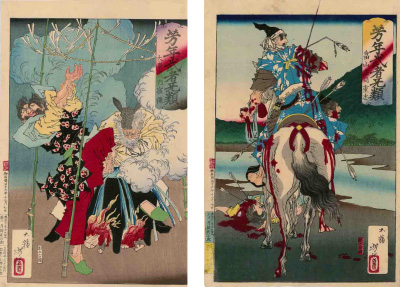
'Yoshitoshi Musha Murui'
“Daijin Takeuchi no Sukune” “Hatakeyama Shōji Shigetada”
Meiji 16th (1883)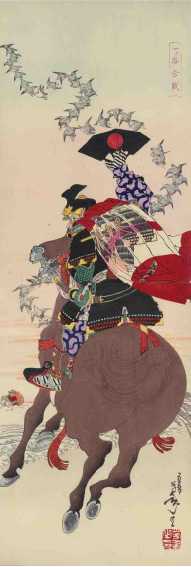
“Ichi no Tani Gassen”
Meiji 18th (1885)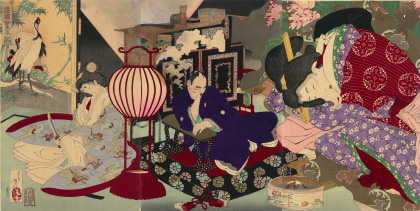
“Gokoku Onna Taihei-ki”
Meiji 19th (1886)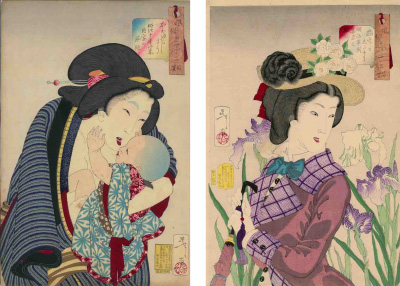
'Hūzoku Sanjū-ni Sō'
“Kawa-yura-shi-sō” “Yūho ga shi-ta-sō”
Meiji 21st (1888)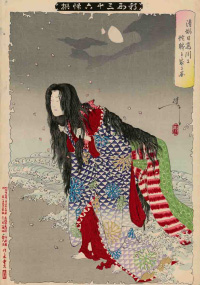
“Shin-kei Sanjū-roku Kai Sen
Kiyo-hime Hidaka-gawa ni Jatai to naru Zu”
Meiji 23rd (1890)
- Yōshū Chikanobu 1838 to 1912 (Tenpō 9th to Taishō 1st)Open or Close
He was born in a family of samurai class. It is said that he studied under Kuniyoshi and Kunisada when he was teen, but after that he studied under Toyohara Kunichika. He came out in the end of Edo period but participated in the war of Boshin, caught by the government army, returned to Tokyo and from about 10th of Meiji, he restarted as an e-shi in the fields of sensō-ga (ukiyo-e of war) or yakusha-e. After that, he got to be popular by san-mai-mono (a work constructed by 3 prints) that were expressed with vivid colors in vogue and with the subjects of customs of westernization. In the end of Meiji 20s when ukiyo-e was starting to declining, he got to be popular among ordinary people by the series of “Chiyoda no Ōoku” or “Chiyoda no Onomote” that are san-mai-mono and whose subjects are about ōoku (the ladies’ chambers) of the Edo castle or the events of the government that were based on his experiences when he was a vassal under shōgun (general) direct supervision. Moreover, in the bijin-ga series of “Jidai Kagami” or “Shin Bijin” that are constructed by 1 print, he established his unique expression as bijin-ookubi-e (beautiful women’s prints with her face mainly) in Meiji with delicate and soft colors. He lived very long and played an active part in Meiji 30s also by creating masterpieces that fit to the time and sending his handwritings to exhibitions. His style was different from the style that was expressed in the next generation in the point of the fusion with modern Japanese drawing. It can be said that he is an e-shi who inherited and developed ukiyo-e to the end.
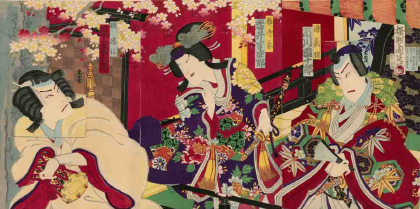
“Yoshitune Sen-bon Zakura (Komochi-e)”
Meiji 14th (1881)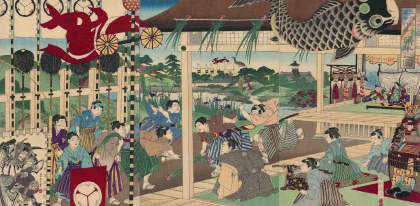
“Edo Sunago Nenchū Gyōji Tango no Zu”
Meiji 18th (1885)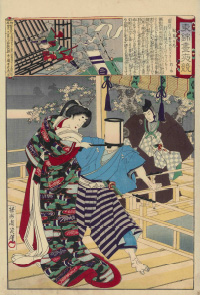
“Azuma Nishiki Chūya Arasoi Matushima-no-tubone”
Meiji 19th (1886)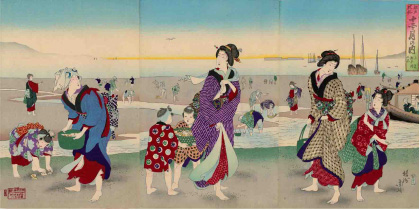
“Edo Hūzoku Jū-ni-ka-getu no uchi San-gatu Shiohigari no Zu”
Meiji 23rd (1890)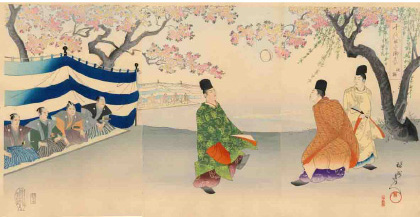
“Chiyoda no Oomote Kemari”
Meiji 30th (1897)
'Shin Bijin'
“Jū-ichi” “Jū-san”
Meiji 30th (1897)
